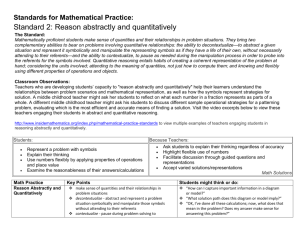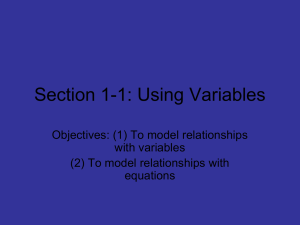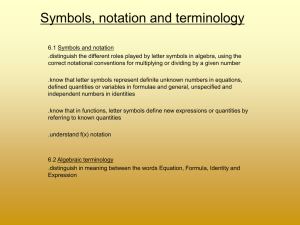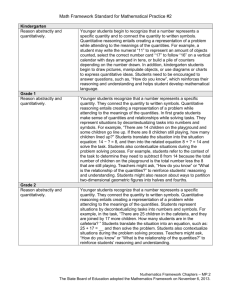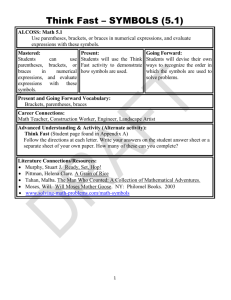Math Practice Standard 2 Progression
advertisement
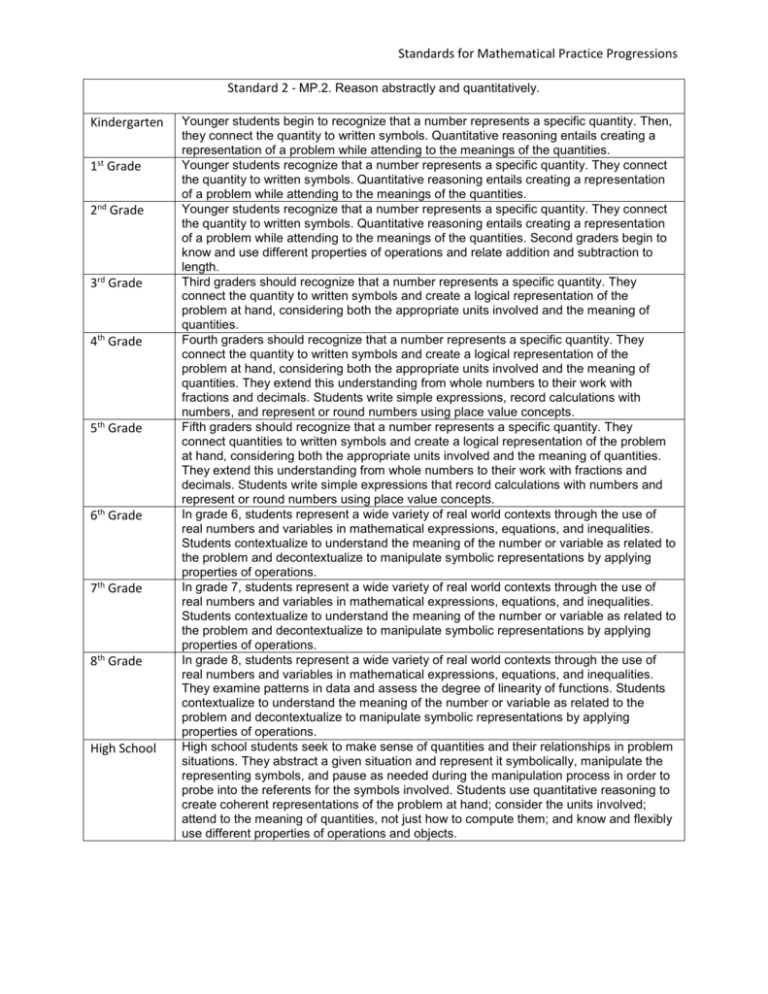
Standards for Mathematical Practice Progressions Standard 2 - MP.2. Reason abstractly and quantitatively. Kindergarten 1st Grade 2nd Grade 3rd Grade 4th Grade 5th Grade 6th Grade 7th Grade 8th Grade High School Younger students begin to recognize that a number represents a specific quantity. Then, they connect the quantity to written symbols. Quantitative reasoning entails creating a representation of a problem while attending to the meanings of the quantities. Younger students recognize that a number represents a specific quantity. They connect the quantity to written symbols. Quantitative reasoning entails creating a representation of a problem while attending to the meanings of the quantities. Younger students recognize that a number represents a specific quantity. They connect the quantity to written symbols. Quantitative reasoning entails creating a representation of a problem while attending to the meanings of the quantities. Second graders begin to know and use different properties of operations and relate addition and subtraction to length. Third graders should recognize that a number represents a specific quantity. They connect the quantity to written symbols and create a logical representation of the problem at hand, considering both the appropriate units involved and the meaning of quantities. Fourth graders should recognize that a number represents a specific quantity. They connect the quantity to written symbols and create a logical representation of the problem at hand, considering both the appropriate units involved and the meaning of quantities. They extend this understanding from whole numbers to their work with fractions and decimals. Students write simple expressions, record calculations with numbers, and represent or round numbers using place value concepts. Fifth graders should recognize that a number represents a specific quantity. They connect quantities to written symbols and create a logical representation of the problem at hand, considering both the appropriate units involved and the meaning of quantities. They extend this understanding from whole numbers to their work with fractions and decimals. Students write simple expressions that record calculations with numbers and represent or round numbers using place value concepts. In grade 6, students represent a wide variety of real world contexts through the use of real numbers and variables in mathematical expressions, equations, and inequalities. Students contextualize to understand the meaning of the number or variable as related to the problem and decontextualize to manipulate symbolic representations by applying properties of operations. In grade 7, students represent a wide variety of real world contexts through the use of real numbers and variables in mathematical expressions, equations, and inequalities. Students contextualize to understand the meaning of the number or variable as related to the problem and decontextualize to manipulate symbolic representations by applying properties of operations. In grade 8, students represent a wide variety of real world contexts through the use of real numbers and variables in mathematical expressions, equations, and inequalities. They examine patterns in data and assess the degree of linearity of functions. Students contextualize to understand the meaning of the number or variable as related to the problem and decontextualize to manipulate symbolic representations by applying properties of operations. High school students seek to make sense of quantities and their relationships in problem situations. They abstract a given situation and represent it symbolically, manipulate the representing symbols, and pause as needed during the manipulation process in order to probe into the referents for the symbols involved. Students use quantitative reasoning to create coherent representations of the problem at hand; consider the units involved; attend to the meaning of quantities, not just how to compute them; and know and flexibly use different properties of operations and objects.
